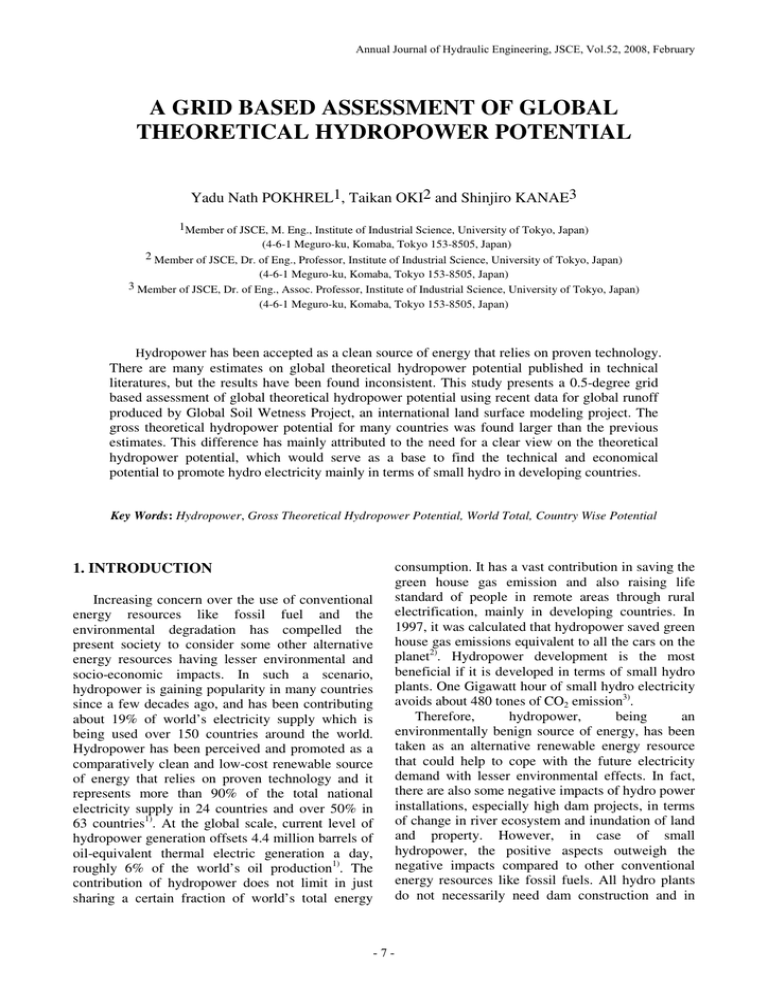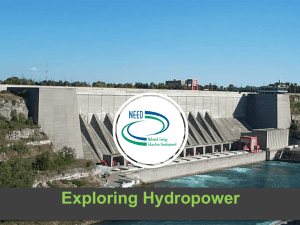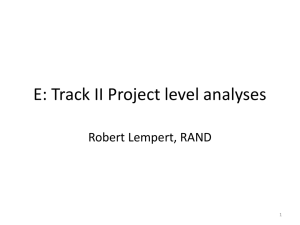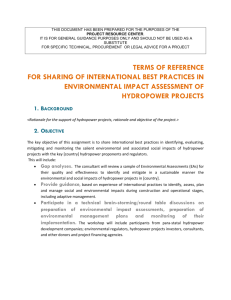A GRID BASED ASSESSMENT OF GLOBAL THEORETICAL HYDROPOWER POTENTIAL
advertisement

Annual Journal of Hydraulic Engineering, JSCE, Vol.52, 2008, February Annual Journal of Hydraulic Engineering, JSCE, Vol.52, 2008, February A GRID BASED ASSESSMENT OF GLOBAL THEORETICAL HYDROPOWER POTENTIAL Yadu Nath POKHREL1, Taikan OKI2 and Shinjiro KANAE3 1Member of JSCE, M. Eng., Institute of Industrial Science, University of Tokyo, Japan) (4-6-1 Meguro-ku, Komaba, Tokyo 153-8505, Japan) 2 Member of JSCE, Dr. of Eng., Professor, Institute of Industrial Science, University of Tokyo, Japan) (4-6-1 Meguro-ku, Komaba, Tokyo 153-8505, Japan) 3 Member of JSCE, Dr. of Eng., Assoc. Professor, Institute of Industrial Science, University of Tokyo, Japan) (4-6-1 Meguro-ku, Komaba, Tokyo 153-8505, Japan) Hydropower has been accepted as a clean source of energy that relies on proven technology. There are many estimates on global theoretical hydropower potential published in technical literatures, but the results have been found inconsistent. This study presents a 0.5-degree grid based assessment of global theoretical hydropower potential using recent data for global runoff produced by Global Soil Wetness Project, an international land surface modeling project. The gross theoretical hydropower potential for many countries was found larger than the previous estimates. This difference has mainly attributed to the need for a clear view on the theoretical hydropower potential, which would serve as a base to find the technical and economical potential to promote hydro electricity mainly in terms of small hydro in developing countries. Key Words: Hydropower, Gross Theoretical Hydropower Potential, World Total, Country Wise Potential 1. INTRODUCTION Increasing concern over the use of conventional energy resources like fossil fuel and the environmental degradation has compelled the present society to consider some other alternative energy resources having lesser environmental and socio-economic impacts. In such a scenario, hydropower is gaining popularity in many countries since a few decades ago, and has been contributing about 19% of world’s electricity supply which is being used over 150 countries around the world. Hydropower has been perceived and promoted as a comparatively clean and low-cost renewable source of energy that relies on proven technology and it represents more than 90% of the total national electricity supply in 24 countries and over 50% in 63 countries1). At the global scale, current level of hydropower generation offsets 4.4 million barrels of oil-equivalent thermal electric generation a day, roughly 6% of the world’s oil production1). The contribution of hydropower does not limit in just sharing a certain fraction of world’s total energy -7- consumption. It has a vast contribution in saving the green house gas emission and also raising life standard of people in remote areas through rural electrification, mainly in developing countries. In 1997, it was calculated that hydropower saved green house gas emissions equivalent to all the cars on the planet2). Hydropower development is the most beneficial if it is developed in terms of small hydro plants. One Gigawatt hour of small hydro electricity avoids about 480 tones of CO2 emission3). Therefore, hydropower, being an environmentally benign source of energy, has been taken as an alternative renewable energy resource that could help to cope with the future electricity demand with lesser environmental effects. In fact, there are also some negative impacts of hydro power installations, especially high dam projects, in terms of change in river ecosystem and inundation of land and property. However, in case of small hydropower, the positive aspects outweigh the negative impacts compared to other conventional energy resources like fossil fuels. All hydro plants do not necessarily need dam construction and in numerous instances, a hydroelectric power plant is clearly economically superior to a comparable thermal power plant2). Hydropower currently provides 17% of the world’s electricity supply, and it clear that it will remain the major contributor in the renewable power sector for the foreseeable future4). The total electricity production in 1990 was some 12,100 TWh/yr of which about 2,240 TWh/yr was supplied by hydropower, or some 18.5 %. This demand is supposed to increase up to around 23,000 TWh/yr in 2,020 of which some 6,500 TWh/yr might conceivably be supplied by hydropower5). Hydropower potential is well distributed around the world. While most of the European and American countries have already exploited a good fraction of the available potential, much of the potential in Asian and African countries still remains untapped. In many parts of Europe, although the hydropower development passed its peak some time ago, there is still considerable activity left, both in uprating and refurbishment, and new developments6). This study aims to provide the detailed geographical distribution of global theoretical hydropower potential in terms of 0.5-degree grid cells. Numerous attempts have been made to assess the hydropower potential of the World, its present use and the future prospects for its utilization. However, the results of these surveys reveal striking inconsistencies5). Such discrepancies can be due to the lack of data sets for some regions and some sort of assumptions made during calculations. Sometimes, due to inconsistent definitions of energy terms and nor-uniform data acquisition may also result in a range of hydropower potential published in different technical literatures. Therefore, this study would be useful to give a clear view on the theoretical hydropower potential estimation of the world, which is based on the recent data sets produced by GSWP2 project for global runoff distribution. 2. DATA USED AND METHODOLOGY The gross theoretical hydropower potential is defined as the energy potentially available, when all natural runoff in a country is harnessed down to the sea level (or to the border line of the country) without any energy loss5). The Eurelectric report also defines the technical hydropower potential as the total hydropower potential at a station wall of all sites, that could be, or have been developed, considering current technology, regardless of economic and other restrictions and the economic hydropower potential as the portion of the technical potential, which can, or has been developed, as cost -8- competitive with other energy resources. All data used for the calculations were 0.5-degree grid based. For runoff, GSWP2-B07) data was used and the averaged data developed from HYDRO1k8) was used for elevation. The country mask and the data for major river basins were adopted from the data prepared for 0.5 degree version of TRIP 9), 10). The gross theoretical hydropower potential can be calculated in two ways. The two methods have been considered as Method I and Method II. (1) Method I P = γ .Q.h (1) Where, P: Power in Watts Q: Discharge in m3/s γ: Weight density of water (9810 N/m3) h: Difference of elevation from the point of consideration to the mean sea level in meters The discharge Q was obtained from runoff data as, (2) Q = R× A Where, R: Specific Runoff generated from the grid cell A: Area of corresponding grid cell This method assigns the potential to a specific grid cell that could be generated from the discharge generated from the cell until it finally flows down to the sea, no matter which path it takes along the continental landmass. Therefore, this method is practical enough to calculate the potential in global or continental scale, but is not much accurate to apply for local scale hydropower potential calculation. In fact, this method disregards the river flow along the continental landmass and flow accumulation in the downstream grids. (2) Method II In this case, equation (1) and (2) are valid but ‘h’ in equation (1) should be the difference of elevation between the considered grid and the downstream one. Therefore, this method assigns a hydropower potential value to a grid that could be produced when the discharge generated within the grid cell flows down to the neighboring grid. Moreover, this method also considers the flow accumulation and termination of flow in some endorheic basins. This method can, therefore, be applied to get reasonable results even in local and regional scales as it regards the fact that power generation is a hydro station along the river system is a local scale issue. However, the accuracy of calculation depends on the size of the grid cell. Method II needs the flow direction map to determine how flow accumulation occurs when water flows to the downstream. In this study, the 0.5 degree flow direction map prepared from 1-degree TRIP flow direction map was adopted10). The flow direction map was used to calculate the accumulated flow along the river channel and hence the hydropower potential with respect to the neighboring grid in the flow direction. As the TRIP flow direction map follows the river bed elevation rather than the mean elevation of the grid, some differences were found with the 0.5-degree elevation data used, resulting in upward slope along the river flow directed by TRIP. However, as the estimation system is linear, it has been assumed that the overall result for a region will not be affected. In this study, the global theoretical hydropower potential was calculated by both methods and was compared with the results of other two previous studies. The grid wise hydropower potential was calculated from equation (1) and then the calculated power potential was transformed into yearly theoretical potential energy as, E= P × 365 × 24 1012 (3) Where, E: Energy in TWh/yr P: Power in Watts The hydropower potential for each country and river basins was then clipped from the 0.5-degree grid based potential using the country code and river basin code respectively, of the same resolution. 3. RESULTS AND DISCUSSION Fig. 1 shows the theoretical hydropower potential distribution around the world in GWh per year, calculated using method I. The total potential of the world (excluding Greenland and Antarctica) counts approximately 58,470TWh/yr. It can be clearly seen that the hydropower potential is high in high altitude regions having relatively high runoff generation; for example in the Himalaya range and along the Ganges River basin in Asia, some part of Canada, upstream part of Amazon River basin and some part of Parana River basin in South America and some countries in Europe like Norway and Sweden. This is simply because of the multiplication of the discharge generated at such high elevation area by the total elevation from the sea level. The hydropower distribution over the world calculated by using method II has been depicted in Fig. 2. This figure gives somewhat more realistic view of hydropower potential distribution than in the former case, both in high elevation and high runoff generation regions. The total hydropower potential was found to be 57,540 TWh/yr. Slight differences observed in the results between these two methods is because of the endorheic watersheds, where the water generated within it and also accumulated from the upstream grid cells does not have any outlet. As there are many discrepancies in previous estimates of hydropower potential, results of this study were compared with some of the results found Fig. 1 Global Distribution of Theoretical Hydropower Potential in TWh/yr – Method I -9- in the relevant technical literatures. The gross theoretical hydropower potential of the world was estimated to be approximately 40,510 TWh/yr11). Based on the best available evidences to that day, gross theoretical hydropower potential of the world was estimated to be 51,000 TWh/yr5). In this study, hydropower potential for each country was derived and used to determine the continent wise potential. Though the second method does not give very accurate results in local scale, the country wise potential was calculated from both methods to compare the results for bigger countries. Table 1 shows the continent wise gross theoretical hydropower potential of the world as obtained from this study and two studies cited above. Even though, the second method considers the endorheic river basins, not much difference was found in the result as compared to that of method I. There are many endorheic river basins, some of them quite large, in Asian region12), but most of them seem not to be identified here due to the 0.5 degree grid size of the elevation data. Use of higher resolution topographic data might give better results for such river basins. Fig. 3 shows the region wise comparison of the results with other two estimates and Fig. 4 presents a comparison of the results of this study in continental scale with the results of World Atlas and Industry Guide11). Africa’s theoretical hydropower potential seems to be overestimated in this study as compared to the one published in World Atlas and Industry Guide. However, Eurelectric estimate shows that Africa is much richer in hydropower having a total potential of about 10,000 TWh/yr. In case of Asia, there is not much difference in the results. The Eurelectric gives the total potential of Fig. 2 Global Distribution of Theoretical Hydropower Potential in TWh/yr – Method II Table 1 Gross Theoretical Hydropower Potential (Comparison with other study results) in TWh/yr World Atlas & This Study Region Industry Guide 11) Eurelectric, 19975) Method I Method II Africa 8758 8453 4000 Asia 21986 21046 19192 Europe 4170 4227 3224 N. America 11081 11436 7196 S. America 10492 10453 6274 Oceania 1986 1925 624 1000 World 58473 57540 40510 51000 - 10 - 10100 23900 16000 Asia and Europe together which is also quite comparable with the total potential of Asia and Europe as resulted from this study and also that of the World Atlas. In case of North and South America and also Oceania region, the World Atlas estimates are much lesser. On the other hand, the Eurelectric results are in between the estimates of World Atlas and this study, same as in case of Asia, Africa and Europe. Though the World Atlas estimates are much lower for all regions, the values are assumed to be not exact as the results for some countries have been assigned with approximate or greater than equality. Therefore, the authors consider that the theoretical hydropower potential of the world could be much higher than estimated previously. Furthermore, no values have been given for some countries but have been assumed to be greater than zero. On the other hand, Eurelectric, results are closer to the results presented by this study, but no details of the data and methodologies were found in the literature. This study, therefore, presents the global theoretical hydropower potential based in 0.5-degree global data sets for discharge and elevation. Moreover, the Continent 1:1 Correlation: 0.965 Correlation: 0.962 Asia + Europe America(N. & S.) Africa 10000 5000 Africa 20000 15000 10000 0 N. America S. America Africa 5000 Europe Oceania 0 0 5000 10000 15000 20000 1:1 Asia Oceania 0 25000 5000 10000 15000 20000 25000 This Study This Study Fig. 4 Hydro. Potential Comparison - Continent Fig. 3 Hydro. Potential Comparison - Region 7000 7000 1:1 Correlation: 0.91 Country 6000 5000 USA 4000 3000 2000 Indonesia Peru Brazil Russia Canada Congo Colonbia 1000 1:1 China 6000 China India Correlation: 0.892 Country World Atlas & Industry Guide World Atlas & Industry Guide Previous Studies 20000 15000 Correlation: 0.965 25000 World Atlas & Industry Guide World Atlas Eurelectric 25000 authors also agree on the fact that the actual potential might be slightly lesser than presented here as the GSWP2 runoff data are overestimated in mid and high latitudes13). Similarly, the country wise potentials obtained from Method I, as shown in Fig. 5, also have discrepancies with the previous results. One of the possible reasons may be because of the inconsistent data acquisition and methodologies adopted in determining country wise potential. For China and Unites States, this study estimates are almost same as previously published ones. However, Method II results, presented in Fig. 6, show a reduction in potential of China and increase in that of United States. This reflects that some rivers flow from China to some other countries and reverse case occurs in case of United States. The potential of Canada is also reduced slightly, which reflects that the rivers in Canada cross the country border flowing into United States. Figures show lesser potential for India than estimated before, but the World Atlas estimate includes the pumped storage potential of about 800 TWh/yr. Including this amount gives almost same results. As we can see in 5000 USA 4000 3000 India 2000 Brazil Indonesia Peru Russia Canada Congo Colombia 1000 Venezuela 0 0 0 1000 2000 3000 4000 5000 6000 0 7000 1000 2000 3000 4000 5000 6000 7000 This Study - II This Study - I Fig. 5 Hydro. Potential Comparison – Country (Method I) - 11 - Fig. 6 Hydro. Potential Comparison – Country (Method II) 1E7 4000 1000000 100000 10000 1000 River Best Fit Line Cumulative Plot • Use of underestimated runoff or rainfall data Therefore, acquisition of the latest data, especially for runoff, is deemed necessary to present the gross theoretical hydropower potential of the world. The theoretical potential does not have direct relation with the real hydropower implementation, but it is an essential part of the whole hydro management scheme to find the technically and economically feasible potentials. Therefore, the higher estimates of this study has mainly attributed to the need of a clear view on the theoretical hydropower potential which could lead the hydro industry towards important steps in determining the technical and economical potentials to promote hydro electricity mainly in term of small hydro in developing countries. 100 60000 50000 Potential (TWh/yr) 3000 40000 30000 2000 20000 1000 10000 0 1E7 1000000 100000 10000 1000 0 100 River Basin Area (Km2) Fig. 7 River Basin wise Hydro. Potential Fig. 5, potential for most of the small countries is higher than the previous estimates. This is by far the most important message of this study for the development of small hydropower in such small and developing countries. If not enough information is available, hydropower potential is calculated by using river discharge of major river basins in the region and the average elevation along the river length. In such cases, the small river basins might have been discarded. Therefore, to observe the contribution of big and small river basins, hydropower potential of around 6,000 rivers around the world was extracted from the total theoretical potential which has been presented in Fig. 7. The dotted line in this figure shows the cumulative potential corresponding to river basins of size greater than about 15,000 Km2, which is approximately same as Eurelectric5) estimates. However, there is still huge potential that can be harnessed from the smaller river basins. Such small rivers are more important in the present situation to promote the small scale hydropower plants to electrify the remote areas in developing countries with very less of environmental impacts. 4. CONCLUSION While there are some disputes in presenting global hydropower potential, this study has revealed the global theoretical hydropower potential in terms of 0.5 degree global grids using the recent runoff data produced by GSWP2 project. This study also draws a conclusion that the hydropower potential over the world could be higher than the previously estimated results. Some of the possible reasons for previously published lower estimates could be; • Unavailability of data sets for some regions • Differences in adopted methodologies, eg. considering only large river basins REFERENCES 1) World Commission on Dams (WCD), 2000: Dams and Development–A new framework for decision-making, The Report of The World Commission on Dams. Earthscan Publications Ltd. London and Sterling, VA. 2) Kaygusuz, K.: Hydropower and the World’s Energy Future, Energy Resources, 26:215-224, 2004. 3) ESHA, European Small Hydropower Association: http://www.esha.be/ 4) World Energy Council: 2004 Survey of Energy Resources. 5) Eurelectric 1997, Study on the importance of harnessing the hydropower resources of the world: Hydropower and other renewable energies study committee, Ref:03000Ren9761. 6) Bartle, A.: Hydropower potential and development activities, Energy Policy, 30 (2002) 1231-1239, Aqua-Media International Ltd. 123 Wesrmead Road, Sutton, Surrey. SM1 4JH, UK. 7) Dirmeyer, P. A. Gao X., Zhao M., Guo Z, Oki T. and Hanasaki N.: Multimodel Analysis and Implications for Our Perception of the Land Surface. Bull. American Meteorological Society, 87, 1381-1397, 2006. 8) HYDRO1k: http://edc.usgs.gov/products/elevation/gtopo30/hydro/index .html 9) Okada Y.: Simulating Discharge of Major River Basins in the World through Development of Global River Channels Network at 0.5 Degree Resolution, Master Thesis University of Tokyo. 10) Oki. T., Y.C. Sud: Design of Total Runoff Integrating Pathways (TRIP) – A Global River Channel Network. Earth Interactions, Volume 2 (1998). 11) World Atlas and Industry Guide 2006: The International Journal of Hydropower and Dams. 12) UNEP:http://www.unep.or.jp/ietc/Publications/Short_Serie s/LakeReservoirs-2/10.asp 13) Decharme, B., Douville, H.: Uncertainties in the GSWP-2 precipitation forcing and their impacts on regional and global hydrological simulations, Clim Dyn (2006) 27:695-713. - 12 - (Received September 30, 2007)




